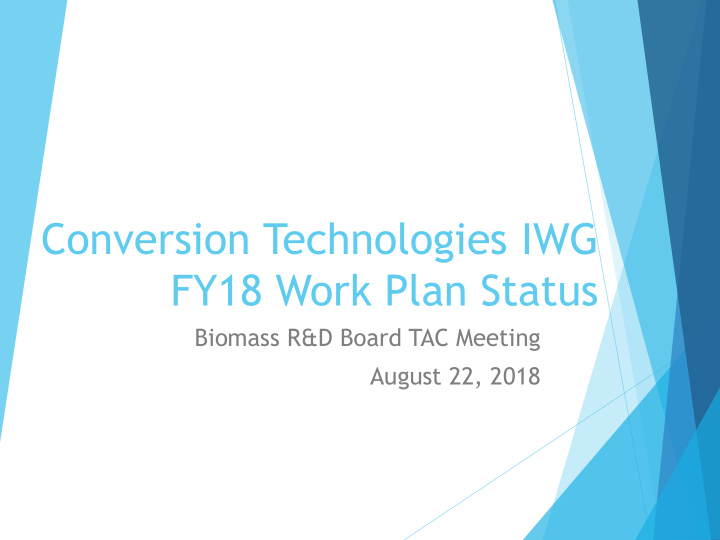



Conversion Technologies IWG FY18 Work Plan Status Biomass R&D Board TAC Meeting August 22, 2018
Key Activities/Deliverables Planned in FY18 Goal #1: Remove barriers to biointermediate refining and upgrading via existing infrastructure. Specific approaches to achieve this goal: • Study and identify key chemical and biochemical technologies to advance biorefining efficiencies. • Address barriers to generating intermediates and products at relevant scales – Develop new and effective biomass handling and pretreatment technologies – Study how inhibitors impact the metabolisms’ of biochemical conversion organisms – Develop strategies to avoid toxicity and/or increase resiliency to it • Crosscutting strategies to avoid toxicity may include interfacing with feedstock genetics researchers to inform them of inherent feedstock constituents that are inhibitors • Conversion-only strategies to increase resiliency include pretreatment processing to remove the inhibitors, and increasing the tolerance of the conversion system (organism or catalyst/solvent) • Focus on new chemical and biochemical reaction engineering and genetic pathway engineering strategies to improve overall system reaction kinetics and conversion product yield – Establish meaningful performance targets in titer, rate, and yield 2
Key Activities/Deliverables Planned in FY18 Goal #2: Address critical risks and uncertainties to improve the prospects for capital investments in the bioeconomy Specific approaches to achieve this goal: • Inform a technical communications strategy to better characterize the advantages and value proposition of a robust bioeconomy • Develop and provide technical advice to relevant agencies on the emerging bioeconomy to help inform appropriate policymaking and regulatory frameworks • Promote R&D in valorizing residual side streams produced in biomass conversion processes 3
Progress Toward FY18 Deliverables Goal #1: Remove barriers to biointermediate refining and upgrading via existing infrastructure. • Using system modeling tools and corresponding process data to identify key processing parameters (chemical and biochemical) for optimizing refining efficiency • Addressing barriers to generating intermediates and products at relevant scales though new catalyst development and biochemical pathway engineering Goal #2: Address critical risks and uncertainties to improve the prospects for capital investments in the bioeconomy • Reported on successful verification case for biomass to jet fuel via gasification, gas fermentation, and ethanol upgrading. • Assessments on the value proposition for new efficiency measures, waste minimization, and carbon utilization have been initiated and reported outcomes expected by the end of the year. 4
FY18-19 Path Forward • Continued efforts to improve efficiencies for intermediate upgrading with improved refining efficiencies • Continued efforts to develop and report on relevant technologies that have been derisked. • New carbon utilization, carbon efficiency, and carbon management goals to be established – CO2 reduction and upgrading – Pathway and reactor engineering strategies for avoiding CO2 evolution during fermentation – Implications for pathway carbon efficiency as a function of carbon source (carbon efficiency versus biomass efficiency) 5
Recommend
More recommend